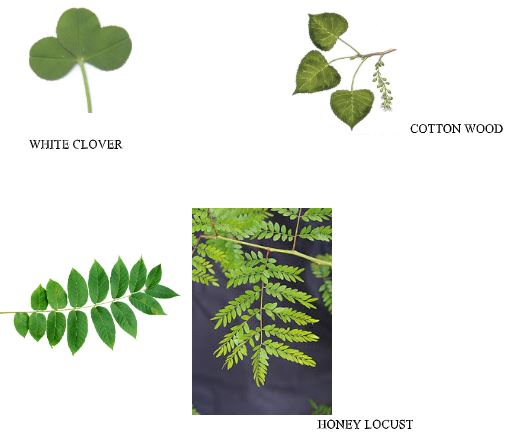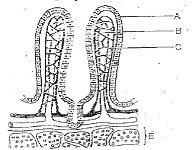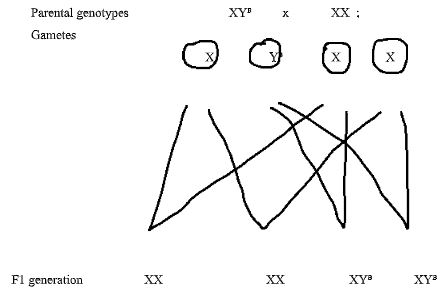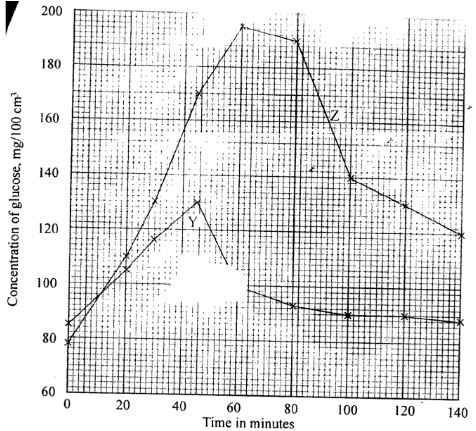Questions
Instructions to candidate
- This paper consists of two sections, A and B.
- Answer all the questions in section A in the spaces provided.
- In section B answer question 6 (compulsory) and either question 7 or 8 in the answer booklet provided.
- Candidates should answer the questions in English.
SECTION A (40 marks)
-
- Using the diagrams below, construct a dichotomous key that can be used to identify the leaves. (2mks)
- State two reasons for classifying living organisms (2mks)
- Using the diagrams below, construct a dichotomous key that can be used to identify the leaves. (2mks)
- The diagram below is a cross section through a part of human ileum.
-
- Identify the structure drawn above (1 mark)
- State the significance of the structure shown above. (1 mark)
- Name the parts labelled A, B and C (3 marks)
- Give the functions of the part labelled B and C (2 marks)
- Name the cell organelle more abundant in goblet cells. (1 mark)
-
-
- In human, premature baldness is controlled by a gene on the Y chromosome. Using B to represent the gene for baldness, work out a cross between a bald man and his wife . (4mks)
-
- What is the probability of their daughters being bald? (1mk)
- Give a reason for your answer. (1mk)
- Name one trait in human beings that is determined by multiple allele. (1mk)
- Name one genetic disorder affecting the red blood cells. (1mk)
- Study the diagram below and answer the following questions.
-
- Identify the type of circulatory system shown in diagram above. (1mk)
- Give a reason for your answer in (a)i) above. (1mk)
- Name the parts labelled X, Y and Z. (3mks)
- Explain the disadvantage of having the above circulatory system in the animals. (2mks)
- Explain why amoeba lack a circulatory system. (1mk)
-
- An experiment was carried out to find out the concentration of ions in the cell sap of an aquatic plant and that of the pond water in which they were found.
Concentration in Ions Cell sap Pond water Na+ 50 1.2 K+ 49 0.5 Mg2+ 11 3.0 Ca2+ 13 1.3 Cl- 101 1.3 SO42- 13 0.67 -
- Name the process by which the aquatic plant absorbs ions from pond water. (1 mk)
- State the four roles of the process you have named in (a)(i) above in a mammalian body. (4 mks)
- Name the cell structure that allows passage of ions in and out of the cell. (1mk)
- How can the rate of uptake of ions by the aquatic plant be increased. (2mks)
-
SECTION B (40 marks)
Answer question 6 (compulsory ) and either question 7 or 8 in the spaces provided after question 8.
- The glucose level in mg per 100cm3 of blood was determined in two person Y and Z. Both had stayed for six hours without taking food. They were fed on equal amount of glucose at the start of the experiment .The amount of glucose in their blood was determined at intervals .The results are shown in the table below.
Times in minutes Glucose level in blood in mg/100cm3 Y Z 0 85 78 20 105 110 30 105 110 45 130 170 60 100 195 80 93 190 100 90 140 120 90 130 140 88 120 - On the grid provided, plot graphs of glucose levels in blood against time on the same axes. (7mks)
- What was the concentration of glucose in the blood of Y and Z at the 50th minute? (2mks)
- Account for the level of glucose in present Y
- During the first 45 minutes. (2mks)
- After 45th minute to the end. (4mks)
- Account for the decrease in glucose level person Z after 60 minutes. (2mk)
- Low blood sugar level in harmful to the body . Explain. (3mks)
-
-
- Give four modes of expressing food relationship in an ecosystem. (4 marks)
- Explain how food as a factor regulate the population of animals in an ecosystem.( 8 marks)
- How are desert plants adapted to conserving water? (8 marks)
-
- Describe the structure and functions of various organelles in a mature animal cell. (20mks)
Marking Scheme
-
-
-
- Leaf compound ……………………………… go to 2;
- Leaf simple ……………………………… COTTON WOOD;
-
- Leaf pinnate …………………………………..go to 3;
- Leaf bipinnate …………………………………HONEY LOCUST;
-
- Leaf margin serrated…………………………...WHITE CLOVER;
- Leaf margin smooth……………………………BLACK WALNUT;
-
-
- Put similar organisms together and separate different;
- Put organisms in correct group for future reference;
- Arrange information about organisms in an orderly manner to avoid confusion
- Establish evolutionary relationship between different organisms
-
-
-
- Villi; rej. Villus
- Increase surface area for absorption of digested food;
-
- Epithelium;
- Lacteal;
- Blood capillaries;
- B- responsible for absorption of fats; rej. Fatty acids and glycerol
C- Important for transporting digested food; - Secrete mucus to lubricate food; Form a protective layer for the gut wall to prevent it from being digested;
-
-
- XYB - bald man(Man/ ♂)
XX - wife (♀/ Woman)
Correct gametes; f1 generation; fusion lines; -
- 0; acc. Zero/ none
- The gene for baldness is located on the Y chromosome which the girls lack;
- Blood group;
- Sickle cell anaemia;
- XYB - bald man(Man/ ♂)
-
-
- Open circulatory system.
- Transporting fluid/ blood flows into the general body cavity/ coelom;
-
- X -Aorta ;
- Y- Ostia ;
- z- Dorsal diaphragm ;
- Blood flows under low pressure; therefore nutrients are supplied to the tissues/ waste products are removed from the tissues at a lower rate;
- It has a large surface area to volume ratio, materials can diffuse into and out of the body fast;
-
-
-
- Active transport;
- Reabsorption of glucose/ salts in kidney tubules; Absorption of digested food from the alimentary canal into the blood stream; Excretion of waste materials from cell of the body; Accumulation of substances in the body to counter osmotic imbalance in saline Environment; STRICTLY IN MAMAMALS
- Cell membrane/Plasma membrane;
- Increasing supply of oxygen/ oxygen concentration;
Increasing supply of glucose/ glucose concentration;
-
-
-
- Y – 120mg / 100cm3 ± 1;
Z – 178mg / 100cm3 ± 1; -
- Blood sugar level increased to 130 mg / 100cm3; glucose is being absorbed from the intestines;
Some of it by – passes the liner without entering the cells thus raising blood glucose level; - Glucose concentration declined to normal 90mg / 100cm3 high blood glucose stimulates the pancreas to produce insulin ; which stimulates the liver cells to take up glucose ; and consists it to glycogen; (4mks)
- Blood sugar level increased to 130 mg / 100cm3; glucose is being absorbed from the intestines;
- Some of the glucose is used in respiration to generate energy; some is lost in urine; (2mks)
-
-
-
- Food web; Food chain; Pyramid of biomass; Pyramid of numbers;
- A lot of food; causes population increase; leading to high rate of reproduction; and immigration;
Little food ; leads to stiff competition (for food) ; leading to low rate of reproduction; high rates of deaths; and emigration; thus reducing the population.
- Leaves are modified to spines/ thorns; to reduce surface area over which transpiration can occur; Shed their leaves during the dry season; to reduce the surface area exposed to transpiration; Leaves have thick , waxy cuticles; to minimize rate of cuticular transpiration. Leaves for some plants can roll or fold; to reduce rate of transpiration by not exposing stomata to environmental factors. Have sunken stomata; which accumulates moisture in sub-stomatal air spaces hence low diffusion gradient thus reducing transpiration rate. Reduced number of stomata; hence low rate of transpiration. Some plants have reversed stomatal rhythm; to prevent excessive water loss by transpiration. Possession of very deep roots; to absorb water from deep in the soil surface; Possession of parenchyma cells in swollen stems and leaves; for storage of water; Many leaves are sclerophylous/ possess resin coatings; to increase reflection of solar radiation ; hence lower transpiration rate.
NB Award transpiration once
-
-
- Mitochondria;
Has a double membrane surrounding it and inner membrane folded to form cristae which increases the surface area for attachment of respiratory golgi body/apparatus, are stack of membrane bound like sac/is a system of membranes sacs/hollow spaces; that transports glycoproteins/carbohydrates and proteins; They package glycoproteins; secrete mucus/enzymes/synthesized proteins. - Lysosomes
Are spherical in shape and enclosed by a single membrane; contain hydrolytic enzyme which destroy worn out organelles, micro-organism/ingest food/breakdown large molecules. - Endoplasmic reticulum
Are membrane bound cavities in cytoplasm; smooth endoplasmic reticulum site for lipid/sterot transport. Rough endoplasmic reticulum ahs ribosome on its surface; and transport proteins. - Centrioles
Rod shaped; located outside the nuclear membrane, for formation of fibs and cilia - Cytoplasm;
It’s a fluid medium; where chemical reaction occurs, contains organelles and inclusions (e.g. glycogen granules, fat droplets and dissolved substances). - Cell membrane
Encloses all cell organelles; has phospholipid layer between two protein layers/it’s a lipoprotein layer has pores that selectively allows substances to pass in and out of the cell/its semipermeable. - Nucleus
Has a double membrane/nuclear membrane around it, which has pores to allow substances in and out of the nucleus; Has nucleoplasm, which contain nucleolus/chromatin, nucleus controls all cell activities, Nucleolus manufactures ribosomes and centrioles. - Ribosomes
Are spherical in shape and suspended in cytoplasm and attached on endoplasmic reticulum; synthesis proteins.
- Mitochondria;
Download Biology Paper 2 Questions and Answers - KCSE 2022 Mock Exams Set 2.
Tap Here to Download for 50/-
Get on WhatsApp for 50/-
Why download?
- ✔ To read offline at any time.
- ✔ To Print at your convenience
- ✔ Share Easily with Friends / Students





